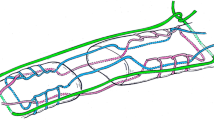Abstract
Introduction
There is a large variety of ruptures of tendons and ligaments in trauma surgery. Reliable data about the most appropriate suture technique and suture material for ruptured tendons are sparse. This human cadaveric study compares the biomechanical properties of three suture materials and three suture techniques for semitendinosus tendon repair.
Method
Sixty-three human cadaver hamstring tendons underwent tenotomy and repair with either Baseball suture, Kessler suture, or a novel “Hannover” suture, using either PDS™ 2-0, Ethibond™ 2-0, or Fiberwire™ 2-0. Biomechanical analysis included pretensioning the constructs with 2 N for 50 s, then cyclic loading of 500 cycles between 2 and 15 N at 1 Hz in a servohydraulic testing machine with measurement of elongation. After this, ultimate failure load and failure mode analysis was performed.
Results
Ruptures repaired by Fiberwire™ as suture material and the Baseball suture technique were able to withstand significantly higher maximum failure loads (72.8 ± 22.0 N, p < 0.001) than the Kessler suture and the Hannover suture, while ruptures repaired by Fiberwire™ and the Kessler suture technique showed the lowest elongation after cyclic loading (14.6 ± 3.8 mm, p = 0.15).
Conclusion
These findings may be of relevance for the future clinical treatment of tendon ruptures. Further in vivo clinical application studies are desirable for the future.





Similar content being viewed by others
References
Clayton RA, Court-Brown CM (2008) The epidemiology of musculoskeletal tendinous and ligamentous injuries. Injury 39(12):1338–1344. doi:10.1016/j.injury.2008.06.021
Bibbo C, Milia MJ, Gehrmann RM, Patel DV, Anderson RB (2004) Strength and knot security of braided polyester and caprolactone/glycolide suture. Foot Ankle Int 25(10):712–715 (857924[pii])
Benthien RA, Aronow MS, Doran-Diaz V, Sullivan RJ, Naujoks R, Adams DJ (2006) Cyclic loading of Achilles tendon repairs: a comparison of polyester and polyblend suture. Foot Ankle Int 27(7):512–518 (931397[pii])
Krackow KA, Thomas SC, Jones LC (1988) Ligament-tendon fixation: analysis of a new stitch and comparison with standard techniques. Orthopedics 11(6):909–917
Burgess R, Elder S, McLaughlin R, Constable P (2010) In vitro biomechanical evaluation and comparison of FiberWire, FiberTape, OrthoFiber, and nylon leader line for potential use during extraarticular stabilization of canine cruciate deficient stifles. Vet Surg 39(2):208–215. doi:10.1111/j.1532-950X.2009.00637.x
Cretnik A, Zlajpah L, Smrkolj V, Kosanovic M (2000) The strength of percutaneous methods of repair of the Achilles tendon: a biomechanical study. Med Sci Sports Exerc 32(1):16–20
Gerdes MH, Brown TD, Bell AL, Baker JA, Levson M, Layer S (1992) A flap augmentation technique for Achilles tendon repair. Postoperative strength and functional outcome. Clin Orthop Relat Res (280):241–246
Haddad R, Peltz TS, Lau A, Bertollo N, Nicklin S, Walsh WR (2010) The relationship between gap formation and grip-to-grip displacement during cyclic testing of repaired flexor tendons. J Biomech 43(14):2835–2838. doi:10.1016/j.jbiomech.2010.06.006
Hausmann JT, Vekszler G, Bijak M, Benesch T, Vecsei V, Gabler C (2009) Biomechanical comparison of modified Kessler and running suture repair in 3 different animal tendons and in human flexor tendons. J Hand Surg Am 34(1):93–101. doi:10.1016/j.jhsa.2008.09.015
Ismail M, Karim A, Shulman R, Amis A, Calder J (2008) The Achillon achilles tendon repair: is it strong enough? Foot Ankle Int 29(8):808–813. doi:10.3113/FAI.2008.0808
Jaakkola JI, Hutton WC, Beskin JL, Lee GP (2000) Achilles tendon rupture repair: biomechanical comparison of the triple bundle technique versus the Krakow locking loop technique. Foot Ankle Int 21(1):14–17
Latendresse K, Dona E, Scougall PJ, Schreuder FB, Puchert E, Walsh WR (2005) Cyclic testing of pullout sutures and micro-mitek suture anchors in flexor digitorum profundus tendon distal fixation. J Hand Surg Am 30(3):471–478. doi:10.1016/j.jhsa.2004.10.014
Santoni BG, McGilvray KC, Lyons AS, Bansal M, Turner AS, Macgillivray JD, Coleman SH, Puttlitz CM (2010) Biomechanical analysis of an ovine rotator cuff repair via porous patch augmentation in a chronic rupture model. Am J Sports Med 38(4):679–686. doi:10.1177/0363546510366866
Cooper DE, Conway JE (2010) Distal semitendinosus ruptures in elite-level athletes: low success rates of nonoperative treatment. Am J Sports Med 38(6):1174–1178. doi:10.1177/0363546509361016
Schilders E, Bismil Q, Sidhom S, Robinson P, Barwick T, Talbot C (2006) Partial rupture of the distal semitendinosus tendon treated by tenotomy: a previously undescribed entity. Knee 13(1):45–47. doi:10.1016/j.knee.2005.05.004
Sekhon JS, Anderson K (2007) Rupture of the distal semitendinosus tendon: a report of two cases in professional athletes. J Knee Surg 20(2):147–150
Acknowledgments
The authors thank Mr. Reinhold Krentscher from the Institute of Legal Medicine for his help. The Fiberwire™ sutures used in this study were donated by the manufacturer (Arthrex®, GmbH, Karlsfeld, Germany). The authors did not receive any writing assistance.
Conflict of interest
The authors declare that they have no conflict of interest.
Author information
Authors and Affiliations
Corresponding author
Additional information
The authors M. Petri and M. Ettinger contributed equally to this study.
Rights and permissions
About this article
Cite this article
Petri, M., Ettinger, M., Dratzidis, A. et al. Comparison of three suture techniques and three suture materials on gap formation and failure load in ruptured tendons: a human cadaveric study. Arch Orthop Trauma Surg 132, 649–654 (2012). https://doi.org/10.1007/s00402-011-1452-9
Received:
Published:
Issue Date:
DOI: https://doi.org/10.1007/s00402-011-1452-9




